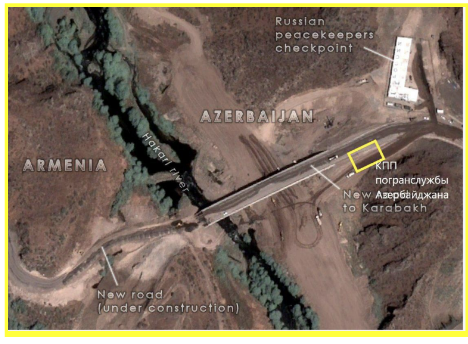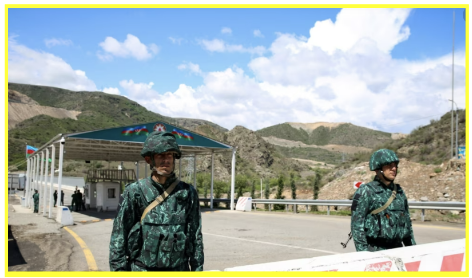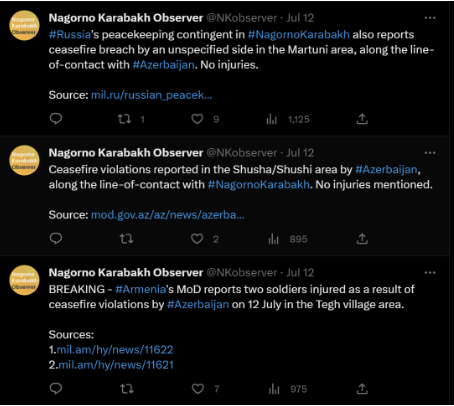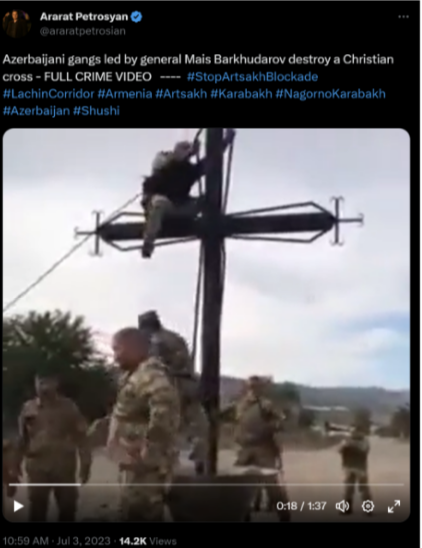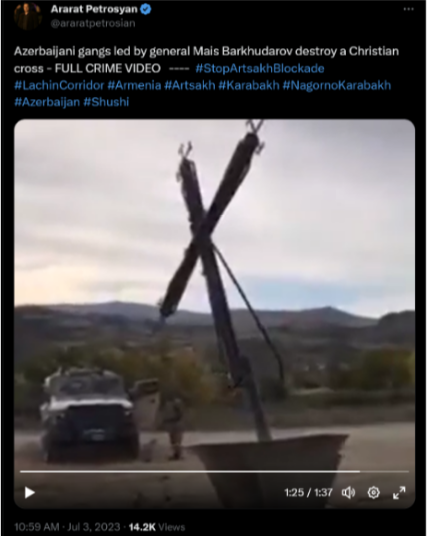Situational assessment: Nagorno-Karabakh
By Erlend Hokholt
Britannica (2021)
The ongoing conflict between Azerbaijan and Armenia over the disputed region of Nagorno-Karabakh, also known as Artsakh, has witnessed a notable increase in tension. There have been ongoing peace negotiations between Armenia and Azerbaijan, lasting for a year and now reaching a critical turning point. Starting in May 2022, leaders and their representatives have gathered in different capitals around the world. The last peace talks took place in June 2023 in Washington DC, where it was hoped that the parties would come closer to an agreement. However, recent developments have cast doubt on the prospects for peace, as new flashpoints and skirmishes have been reported between opposing forces.
Nagorno-Karabakh is a small area within Azerbaijan's borders and is home to different minority groups. The main disagreement concerns the sensitive issue of ethnic Armenians living in Nagorno-Karabakh. This issue has been one of the main points of contention in the unresolved conflict between Armenia and Azerbaijan since the break-up of the Soviet Union.
Following the conflict in the 1990s, the Armenian side achieved success and gained control over territories that extended beyond the original boundaries of the region from the Soviet era. They maintained control over these areas for more than 25 years. However, in the 2020 war, the Armenian forces were defeated by the Azerbajiaan forces, resulting in approximately 120,000 local Armenians now living in a much smaller enclave. This territory is now monitored by Russian peacekeepers, and Azerbaijan gained control over all the surrounding territories.
Over the past year, the Armenian leadership has made notable concessions, including officially acknowledging Azerbaijan's territorial integrity, encompassing Nagorno-Karabakh. However, for the peace treaty to proceed, Armenia insists on the inclusion of special rights and security assurances for the Armenian population in Nagorno-Karabakh. International mediators also support the idea of implementing specific measures considering the prolonged conflict and the recent 2020 war. The de facto leadership of Nagorno-Karabakh maintains its claim of independence, though no country in the world recognises it as an independent state.
Arayik Harutyunyan, current president of the de facto leadership of Naghorno-Karakbh (Armen Press)
Lachin corridor: escalation and border control
2022 witnessed a growing escalation of tension between Azerbaijan and Armenia, which further intensified into 2023, resulting in skirmishes initiated by both sides. However, in mid-December, the situation took a significant turn when Azerbaijan-backed activists set up a blockade of the Lachin corridor. The crisis reached its peak when Azerbaijan violated the 2020 peace agreement by setting up a checkpoint on the Lachin corridor on the other side of the Armenian border on 23 April 2023. The Lachin corridor serves as the sole passage from Armenia to the Nagorno-Karabakh enclave, and the presence of the checkpoint is impeding the crucial flow of medical and food supplies.
Peace talks in May 2023, mediated by the US, the EU, and Russia, carried a small hope for progress in the resolution of the conflict and opening up of the Lachin corridor. However, recent developments indicate a starkly different reality. Fighting has intensified, peace talks failed, and the blockade is still active.
Map: Lachin corridor, Economist Intelligence (2023).
Photo 1: Satellite image of the border crossing between Armenia and Azerbaijan.
Photo 2: Azerbaijan soldiers guarding the border crossing (2 May, 2023).
Photo 3: Image of the checkpoint over the bridge. (23 April 2023).
Recent developments
May 2023
Verified data have reported that the number of armed clashes along the Armenia-Artsakh-Azerbaijan Line of Contact has doubled from May to April. At least one Armenian and two Azerbaijani servicemen died in the area of Sotk, in the Gegharkunik region of Armenia, on 11 and 12 May. Separately, on 26 May, Azerbaijani border guards detained two Armenian servicemen near the country’s southern border with Armenia, in a probable response to the detention of two Azerbaijani servicemen who strayed from the Azerbaijani Nakhchivan exclave into western Armenia in April.
Furthermore, on 15 June, Azerbaijani authorities reported an injury of a soldier at its border checkpoint on Lachin road after shots were allegedly fired from Armenian territory, Armenia reported the same day an injury of its soldier in the same incident, alleging Azerbaijanis sought to advance into Armenian territory to plant a flag.
June 2023
Azerbaijan authorities have reported clashes in several regions located around Nagorno-Karabakh, including in Fuzuli, Agdam, Shusha, and Khojaly regions, and accused “illegal Armenian armed detachments” (military forces reporting to de facto Nagorno-Karabakh authorities) of seeking to construct fortifications. These de facto authorities reported on 22 June an injury from clashes in the Martakert region and rejected the allegations from Azerbaijan authorities.
July 2023
The situation continues to evolve rapidly, with ongoing new developments emerging. Multiple sources have reported new clashes between the opposing forces, indicating further escalation of hostilities.
Photo 1: Twitter user @NagornoKarabakhobserverver reports new clashes on 12 July 2023.
Photo 2: Reported cases of violation of the ceasefire from the Russian defense ministry on 13 July, 2023 filming Azerbaijani soldiers firing mortars.
Forecast and Implications
Peace talks disrupted by skirmishes at home
The ongoing peace talks in Washington DC have been severely disrupted by the reported skirmishes occurring in the region, further exacerbating the existing distrust between the parties involved. Both parties are accused of committing war crimes, particularly against civilians and religious minorities. Acts of violence targeting civilians and the destruction of religious symbols, are likely to intensify resentment among factions and significantly undermine an already fragile peace process. Recently surfaced videos (see below) depict Azerbaijani soldiers desecrating a Christian cross in the Vorotan region (Kubatlu), highlighting just one instance of a series of violations suppressing civilians' rights and disregarding fundamental human rights
Unrest in Armenia
There have also been ongoing protests in several cities in Armenia against the current Prime Minister Nikol Pashinian government and a call for his resignation from office from the opposition, after the loss of territories to Azerbaijan during the 2020 conflict and the governments signaling of concessions in the peace talks to Azerbaijan. The protests have also been targeted against Russian forces stationed in the country. There is growing dissatisfaction with Russia's inability to fulfill its mandate as a peacekeeping force and its lack of controlling Azerbaijan forces in the disputed areas. The unresolved conflict in Nagorno-Karabakh will most likely be contributing to more political tension and growing insecurity in Armenia in the future.
Anti-government protests encouraged by the opposition in Armenia on May 13, 2023 (RFE/RL)
Weakening Russian influence and growing Western participation
Russia's position as a regional player is weakened after the Ukrainian invasion, creating a power vacuum in the region. An example of the weakening of Russian influence is its weak response to the Azerbaijani blockade of the Lachin corridor where Russian peacekeepers were supposed to keep control. The Moscow response to the incident was a “non-committal general condemnation of the violations”. While the EU and the US were more clear and expressed open concerns about the situation, however, they are still focused on a diplomatic solution to the situation.
There is now a change in the power balance between the actors, where the US and EU are gradually taking over the role as the key mediator from Russia. The US initiated strategic peace talks in Washington between the parties. The EU is strengthening its position as a mediator and has expressed a willingness to focus on the region through several initiatives such as the civilian project “EUMA Armenia” and other diplomatic approaches.
The negotiation between Armenia and Azerbaijan is being characterised as a parallel effort. Both the EU and the US are making two parallel attempts at talks between the two countries. Meanwhile, Russia is urging a peace talk process from their side, but with less success. Finally, Türkiye, a traditional military ally of Azerbaijan, has also opened diplomatic relations with Armenia. Türkiye may see the power vacuum as an opportunity to strengthen its position in the region as well.
Furthermore, Azerbaijan may have an interest in stalling the peace talks effort while they have military success on the ground. Azerbaijan's stance is unlikely to change unless Russia, the EU, or the US exert significant pressure, such as imposing substantial sanctions or considering military intervention.
Armenian Foreign Minister Ararat Mirzoyan and Azerbaijani Foreign Minister Jeyhun Bayramov with the US Secretary of State Antony Blinken in Washington D.C., 5 May 2023 (CommonSpace.EU).




